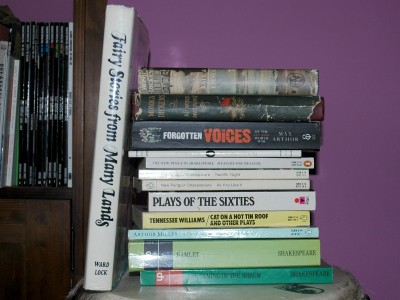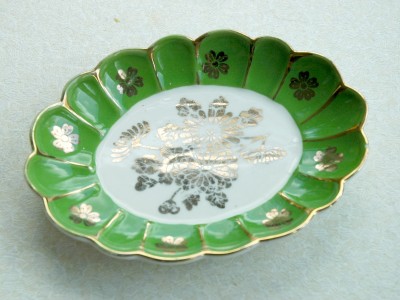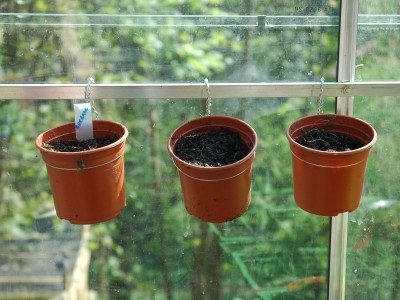Charity shopping, planting and making – my fun weekend :)
Last night on Twitter, I asked people to put their hands up if they’d had a lovely afternoon in their garden/at their allotment yesterday and I got a sea of hands waving back – it is really bloody lovely out there at the moment, isn’t it?*
On Saturday, I blew my no spending month thing out of the window by going to a craft sale at Kirkgate Studios in Shipley – well, actually, I only bought two balls of wool and a postcard from there but since I was in Shipley… As with most poorer areas, you’re less likely to find exclusive designer goodies going for £1 but with eight charity shops, there is at least plenty of choice.
I bought 13 books. Thirteen! But 10 of them were (drama) work-related and two Monica Dickens books I’ve been considering buying off Amazon/Abebooks for a couple of months, so it wasn’t all spur-of-the-moment spend-spend-spend. Plus, eight of the books were in a 4-for-£1 offer so all 13 books cost £7.70 in total — not too bad. (And I’ve already found seven books to give away under my “buy 2, get rid of 1 old one” rule.)
I also bought a cute small plate to be our kitchen soap dish for 50p, another little dish for 50p because it was a tourist souvenir from Baghdad (and how often do you see those?) and a fake-patchwork duvet cover for £1.50, which I’ll turn into a cheat quilt like Lynsey’s from SwirlyArts made this time last year — again, something else I’ve been looking out for because I love Lynsey’s quilt so I was very happy to find it :)
Anyway, after all that spendery on Saturday, I declared Sunday would be a day for the garden. I didn’t get as much done as I’d hoped (I’ll have to have some time off this week to get the rest finished) but I potted on lots of tomatoes & pumpkins, sowed nearly all my potatoes as well as more lettuce & annual herbs. I also made two new scrap wood planters – not the prettiest but certainly the easiest ones yet.
I believe the sides are old scaffolding planks or similar — John’s dad had a trailer full when we went over the other day. He said “they’ll be great for burning” until he saw me hugging them to my chest and squealing with planter-building delight. They’re about 3ft by 1ft by 8inches deep, with reclaimed decking for the bottom supports. Again, they’ll be lined but I think I’ll see how far I get cleaning them rather than painting them as I like the character of the wood. (Apologies for the somewhat shadowy photo – was in a hurry, camera battery was dying.)
I also made some super quick wire wall mounts for some herb pots in the greenhouse – I’ve run out of room on my staging/the floor at the moment so wanted these little pots (and five with baby sage seedlings in them) out of the way. I’ll have to make sure they don’t dry out too much but they’ll probably be fine for now.
Oh, and I also cleaned the windows for the first time this year on Saturday evening – they were, as you may expect, rather filthy but I did a rather good job, even if I do say so myself – not a single water spot in sight! ;)
* (People in parts of the US still in the soggy tailend of winter and people in the southern hemisphere who are heading into full on winter – sorry to gloat about our sunshine. We’re just not used to this nice weather in the UK and you know, talking about it is our national pastime.)
What did you get up to this weekend? Any frugal fun? Or planting progress?
Read MoreAn afternoon of sowing and potting on
Just so I’ve got a record of what has been planted/potted on and when — and what I have to do on Sunday.
Sown:
- Achocha – weee, I’ve been super-excited about these since I heard about them from The Cottage Smallholder
- Borage – for my mini forest garden bed
- Broccoli – misc cheap variety
- Broccoli Rabb/Rapini – only heard about this at the weekend but very excited about them
- Carrots – just a misc variety I picked up for 75% off late last year
- Courgettes – two hybrid varieties (Cavali F1 and Parthenon F1)
- Dwarf beans – some from the packet, some from saved seed
- Marigolds – I don’t normally do flowers but a good companion plant. Winning of the weirdest seeds of the day award – they looked like baby octopus tentacles.
- Oregano – winning the tiniest seeds of the day award
- Perpetual spinach – leftover from last year, not sure how they’ll do
- Sweet peas – the only other flower generally allowed here
Potted on:
- Butternut squash
- Cucumbers batch #2
To sow at the weekend:
- Lettuce – more tom thumbs for when the current batch are harvested
- Mixed CCA salad leaves – ditto
- All sorts of wildflowers
- Cat grass & cat nip
- The rest of the potatoes
- Greens for the chickens if I make a feeder like Kate from Living the Frugal Life
To be potted on/transplanted at the weekend:
- Tomatoes – first batch big ones and the smaller second batch ones
- Swiss chard
- Beetroot
- Potatoes – well, not transplanted on but the very earlies need levelling up
Poll: what seeds have you started so far this year?
I’ve been seeing lots of people blogging and tweeting about their greenhouse contents recently – what’s been sown and when. It’s interesting that some people nearby are planting some of their things much later than me – but other things earlier. I guess we all find our sweet spots between ours schedules and our plants’ demands.
Anyway, I thought it would be fun to see what people have sown up until now so I made a poll – feel free to tick all that apply. Sorry some things have been grouped together and other things have been missed out entirely — the only way to avoid the list getting super-super long!
I’ve put my answers in now but I’m hoping to add to it by the end of the day – I’ve got a whole load of “to plant in April” things just begging to jump into soil!
Read MoreTomatoes: determinate or indeterminate, that is the question
I think I’ve just about reached the stage where my first set of tomatoes needs potting on.
These are the ones that survived the Great Damping Off Disaster of 2011 and they seem to be doing quite well. I have some later ones that are still in modules – they’ll need moving up a stage in a week or so but I think this first batch could use moving on ASAP as I think they’re a little cramped now and starting to suffer as a result.
Up until now, I’ve been more interested in the resulting type of tomato than the actual growing process – I’m a naughty gardener, naughty naughty – and I suspect my crops have suffered as a result.
Now that I’m trying to be more efficient though, I want to do things right. This “potting on” stage now will potentially be to the plants’ final destinations so I’ve been reading about determinates/indeterminates and that sort of thing to make sure the right tomatoes end up in the right pot. According to the wonderful Wikipedia,
Determinate, or bush, types bear a full crop all at once and top off at a specific height; they are often good choices for container growing. Determinate types are preferred by commercial growers who wish to harvest a whole field at one time, or home growers interested in canning. Indeterminate cultivars develop into vines that never top off and continue producing until killed by frost. They are preferred by home growers who wish ripe fruit throughout the season.
I have planted three main types of tomatoes this year: some rich Roma plums for sauces, some sweet cherry tomatoes (Sweet Million F1 – I sowed some yellow cherry Golden Nuggets as well but they all died in the aforementioned Damping Off Tragedy), and some “standard size” Moneymakers. Nothing too exciting but some variety – some for now, some for sauces, some for whatever.
According to a bit of Googling around, I’ve found Roma tomatoes are a determinate bush, Sweet Million an indeterminate vine and Moneymaker is another indeterminate vine, albeit with slightly bigger fruit.
I had hoped to grow some in the greenhouse (in big pots and growbags) but had thought I’d take advantage of some vertical height in the garden by growing some in hanging baskets/upside down containers too. (Although I’d keep said baskets/containers in the greenhouse for at least another few weeks until it gets a bit warmer.)
eHow (which I admittedly always read with a slightly sceptical eye) tells me:
For baskets, you will want to use determinate tomato plants because they will not continue to grow bigger than the basket can hold, while indeterminate ones will.
But equally, I have to consider tomato size:
The size of the tomato plays an important role in whether or not it is going to be best for growing in baskets. Traditionally, there is less room in hanging baskets for a plant to reach full maturity. Therefore, cherry tomatoes, grape tomatoes and other dwarf tomatoes will work best in hanging baskets.
Ok… The “standard size” indeterminate Moneymakers seem destined to grow as cordons from pots/bags in the greenhouse – easy peasy. But what about the Roma & cherry tomatoes? The determinate Roma may be suitable for a hanging basket as they won’t sprawl, but perhaps the plum size fruit will be too big/thirsty for in a basket? The cherry tomatoes are the perfect size for a basket but my variety’s indeterminate nature may cause problems there…
Any experienced tomato growers care to weigh in? Do you prefer all determinate or all indeterminate or a combination of the two?
Read MoreCreating miniature forest gardens?
On Wednesday Linda pointed out that my sawing wood avoidance isn’t lazy but “efficient”. Yes, *cough*, efficient, I concur.
I’m trying to be as efficient as possible in the garden this year – both according to that meaning and the conventional one — and from that and some recent reading, I’m thinking of creating two small forest gardens spots in my garden.
For those not familiar with the idea, forest gardening is a way to multicrop one area – growing (usually) edible plants, shrubs and trees at up to seven different levels, from the treetop canopy levels to ground cover and even root veg. You can create them at a forest scale or even just in small container. It’s efficient in terms of space – a variety of potential food from one area – and can be efficient in the not-sawing-really-lazy sense too if most/all of the layers are perennials or self-seeders.
Both spots I’ve thinking about are in raised beds underneath trees – the first underneath a super tall 100 year old silver birch, then second under a recently planted (currently 2 years old) morello cherry. The silver birch would be canopy layer-plus-plus as it’s miles away from anything else. The cherry, which is on semi-dwarf rootstock, will grow to no more than 2.5m-3m tall so is more at the second layer, the “low tree layer”.
The idea is to have a wedge shape if at all possible – the tall things at the back, the short things at the front, so everything gets sufficient light. The trees are, usefully, in just about the right position for this – towards the back of the space (or at least with ample space to the front) and positioned so that they won’t block the sun. (The back of the house, and thus the garden, is east-facing but the southern facing aspect is completely open too so the silver birch bed gets full sun from about 10am until 4pm-5pm in the summer, and the cherry space from dawn until 2pm.)
Both spots are small and both trees will be pretty thirsty, so I probably won’t be able to plant a full set of layers of demanding fruit & veg but I think there is potential for some stuff. Even if I’m not growing huge amounts of anything in particular, as long as it’s not taking me a lot of effort, it seems to be a good use of space – especially as they’re underused/used as a dumping ground as the birch bed (at the top) is used now.
I’ve already started to plant some shrub-layer fruit bushes under the silver birch – some raspberries that’ll hopefully grow to 3ft-4ft tall. I don’t think the bed is deep enough towards the front for root veg but it’ll certainly be fine for herbaceous things — it would make sense to put borage in there (which grew to between 2-3ft last year) because it’s near the chickens who love borage and I’ve got some chard just starting off, which could go in front of that. Finally, I’m not sure I’ll have any spare plants this year but hopefully once my strawberries start multiplying, I could plant some runners as ground cover/to topple over the edge. Borage self-seeds, chard can (can’t it?) and strawberry runners will last a few years before needing swapping out – so that, in theory, sounds like it could be a lazy efficient bed.
There is only about half that space around the cherry tree so I can’t pack it out. I think big berry bushes would overwhelm the space and clash with the lower tree branches but might get away with some shorter fruit bushes – possibly a small blueberry bush (I’ve seen some that are only about 2ft tall), and when I can propagate children from my cranberry & lingonberry bushes, I could include their offspring there too (the cranberry “strands” could flop over the side of the raised bed). I guess I wouldn’t be adding either of those things this year – which would probably be good as it would let the cherry tree get established in the meantime. I wonder if there is anything not resource crazy that I could put in there now… possibly some not-moisture-crazy herbs? Rosemary? Lavender? I have some little lavender plants in the nearby herb bed which could be transplanted without too much disruption and some other rosemary plantlets nearly ready to be planted out too.
One layer I’ve not talked about is climber/vines – which is the seventh layer. If I thought kiwis or grapes would grow well enough this far up north, I’d possibly consider them for climbing up around the silver birch. Is there anything else in that category that would work? I guess I could leave some space for annual vines – “climbing” squash or something but they are very resource intensive. I’m going to make sure the beds are well enhanced with organic matter before I start but it seems silly to overload them straight afterwards.
Has anyone else created any really small scale “forest gardens”? Is there anything to watch for or need to consider? Any suggestions/advice about my initial plant choices?
Read More










